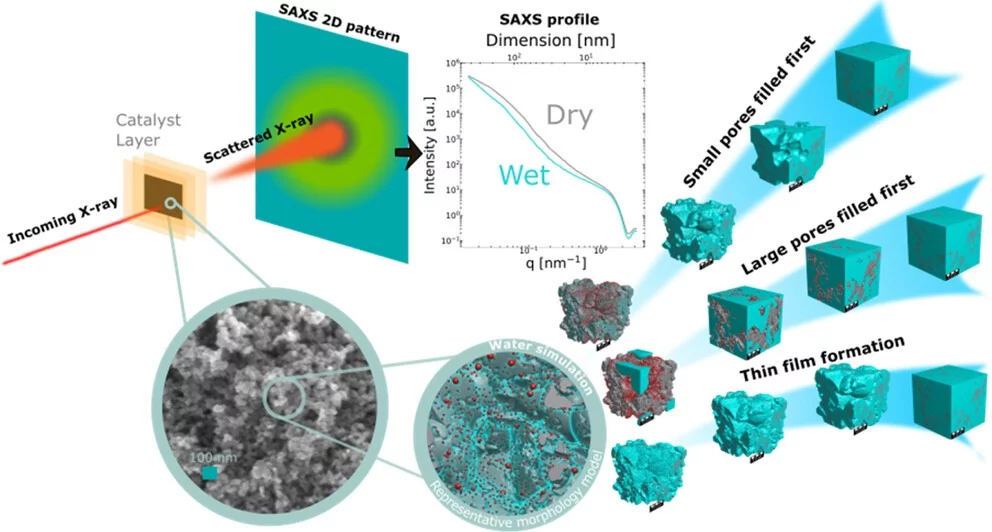The complex nature of liquid water saturation in polymer electrolyte fuel cell (PEFC) catalyst layers (CLs) greatly affects the device performance. To investigate this problem, a method to quantify the presence of liquid water in a PEFC CL using small-angle X-ray scattering (SAXS) was developed in a collaboration of researchers of the Federal Institute for Materials Research and Testing (BAM, Berlin, Germany), the Photon Science Division and the Electrochemistry Laboratory of PSI. The method leverages the differences in electron densities between the solid catalyst matrix and the CL-pores filled with liquid water under dry and wet conditions, respectively.
This small angle X-ray scattering methodology has been applied to porous model materials and a conventional carbon-supported platinum nanoparticle (Pt/C) catalyst layer in ex situ and in situ measurements. First, the detectability of liquids in the different nano-porous layers was demonstrated and it was shown that the liquid saturation can be quantified using SAXS. Second, in silico experiments and stochastic modeling were used to interpret the complex multiphase material by generating statistically representative 3D real-space structures of intersected Boolean models. In silico simulated SAXS intensity profiles were shown to capture the differences in pore-filling modes, specifically considering whether small or large pores get filled with water first, or if the liquid water forms as a homogeneously-distributed thin film. Third, the in situ wetting behavior of a Pt/C catalyst layer used as the working electrode in a liquid electrolyte flow cell was investigated with the new method. We observed that mainly small pores and a limited fraction of large pores filling are being filled simultaneously after the liquid electrolyte got in contact with the catalyst layer. The time resolved in situ measurements furthermore showed that the saturation level in the catalyst layer increased sharply to a saturation level of ≈65% within 3 minutes and plateauing thereafter at ≈70%.
The presented SAXS data analysis tools and approach are foreseen to enable the determination of the water saturation level and the water wetting mechanism in catalyst layers given the development of an appropriate SAXS-compatible operando setup in the future. This, in turn, will close the gap of currently available diagnostic methods that cannot provide insights into pore size specific saturation in the catalyst layer under operando conditions on a wide nm-scale, and will enable advancements in catalyst layer design.
Contact
Dr. Jens Eller
Scientist, Fuel Cell Systems and Diagnostics Group
Paul Scherrer Institut
5232 Villigen PSI
Switzerland
Telephone: +41 56 310 23 96
E-mail: jens.eller@psi.ch
Original Publication
Quantification of PEFC Catalyst Layer Saturation Via in Silico, Ex Situ, and in Situ Small-Angle X-Ray Scattering
Kinanti Aliyah, Christian Prehal, Justus S. Diercks, Nataša Diklić, Linfeng Xu, Seçil Ünsal, Christian Appel, Brian R. Pauw, Glen J. Smales, Manuel Guizar-Sicairos, Juan Herranz, Lorenz Gubler, Felix N. Büchi, Jens Eller
ACS Appl. Mater. Interfaces 15, 26538-26553 (2023).
DOI: 10.1021/acsami.3c00420
Acknowledgement
Swiss National Science Foundation (SNSF), Swiss Federal Office of Energy (SFOE), EU Horizon 2020 research and innovation program, Umicore GmbH & Co KG, and Chalmers initiative for advancement of neutron and X-ray techniques are kindly acknowledged for supporting this research.

